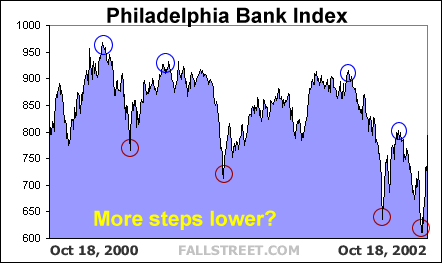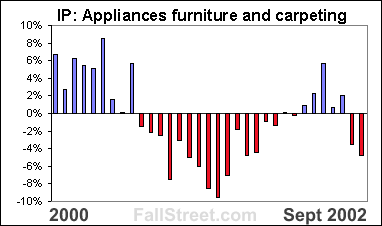October 18, 2002 - 6:45 PM
Banking on a Recovery
The technical, short induced relief rally is losing momentum. Improving economic fundamentals are required to propel stocks higher.
With financial stocks taking control this week there is reason for hope. To be sure, financial stocks can comment on future expectations for consumer borrowing, on business spending, and on the overall health of the U.S. economy and financial markets. Whereas other industries can rise fall based upon safe haven flows, commodity prices, or localized cyclical trends, financial stocks cannot, at least not for very long. Rather, F-stocks are the heart of the economy – as they pump harder, or as prices rise, this suggests that the economy is gaining vitality.
 |
However, and much like BKX top of 803 set on August 22, even ‘hope’ has its limits. Quite frankly, the bounce in bank stocks is troubling because it has not yet conveyed that the rally anything more than simply another new low; another step higher before another step lower. This is not to say that the average cannot sustain strength in the coming weeks and months and eclipse 800 – maybe it could. Nevertheless, now that the bounce is over the argument that future gains will be tougher to come by is reasonable. Further, the contention that financial stocks will stop applauding 3Q02 operational EPS results and start pricing in future expectations is sane. In sum, financial stocks could soon begin to take their cues from U.S. economy, and this a dangerous proposition.
With the bank index chart in mind, the main theme in the markets today is exposed: or that an improving stock market outlook (a new market bottom) has helped to feed investor optimism. However, it is necessary to contextualize this optimism: yes, there is room for volatility and perhaps even further stock market gains, but is there room for the cycle of lower highs and lower lows to be broken? Not many, justifiably so, are convinced.
Economic Activity Continues To Slow
The news this week on the economic front was disturbing: September Industrial production declined by 0.1%, capacity utilization remained flat, the ECRI Weekly Leading Index declined sharply, and the diffusion index of current activity (Philadelphia Fed) crashed from 2.3 in September to -13.1 in October. And while consumer prices came in only a tick below expectations, components of Philadelphia Fed offered proof that the case for deflation is not yet dead:
“For the first time in eight months, more firms reported lower prices for their final manufactured goods (16 percent) than reported higher prices (9 percent).” Philadephia Fed
The one bright spot remains the housing market - in September housing starts soared (1.84M versus 1.64M in August). However, and as has been mentioned before, new homeowners are not furnishing their homes at a pace fast enough for production to rise. Instead, the appliance, furniture, and carpet component of the industrial production report displayed further entrenchment in September, suggesting that current capacity is high enough to meet demand (as it is in most industries), and that undertaking new capital investment plans would be imprudent.
 |
Yes, financial stocks act as the heart of the economy. However, if the economy doesn’t gain momentum, and this probably one of few absolutes when investing, as a group f-stocks will drop. Until f-stocks drop hope is alive, even as the economy continues to falter.
Underfunded U.S. pension Plans Threaten to Depress Prices in 2003
Not unlike how the U.S. government makes promises to recapitalize Social Security even as they dip into the funds from time to time, U.S. corporations are promising to refund pension plans even as stock prices continue to drop. For example, IBM argues that $1.5 billion annually is required to refund its pension plan, which the company says should be fully funded by 2005. But what if the stock markets remain flat until 2005?
Just over 1-week into 3Q02 earnings season and many companies have touched on the pension fund problem: General Electric, General Motors, Ford, IBM, and numerous others – each have had good things to say pertaining to EPS results, but little to say (all bad) regarding their pension funds. Incidentally, many airlines and steel companies, which are notorious for reporting pension fund short falls, have yet to report. Many will likely have some bad news on pension front in the near term, even if the companies do not have wonderful things to say about EPS results.
Pension fund Recap
Merrill Lynch issued a report earlier this year that stated that of the 346 S&P 500 companies offering pensions plans 98 percent were expected to be underfunded by year-end. All toll, Merrill estimated plans would be underfunded by $640 billion. As for the $640 billion figure, this was taking into account a ‘18 percent decline in stocks and 10 percent rise in bond yields, with plan holdings generally 60 percent stocks and 40 percent bonds.’ It remains to be seen whether or not these totals will be attained by year-end.
Following the Merrill report countless sources tackled the pension fund issue with a considerable amount of skepticism. Reports that 2001 earnings would have been lower by 6% if the impact of pension funds were not included surfaced (interest costs and expected asset returns) – then conclusions that 2002 earnings results were being inflated by as much as 10% arrived (for the 12 months ended June 30, 02). Furthermore, just a couple of days ago Fitch warned that pension fund shortfalls for automakers may reach $30 billion by the end of the year, or more than double the total from last year. Suffice it to say, the pension issue is not going away. Rather, it is threatening to become an even more serious problem heading into 2003. Merrill previously calculated that corporations have estimated that long term returns will be in the order of 9.3%. This week IBM downgraded its pension fund expectations from 8.5% to 8%. No doubt, others will continue to follow suit.
Nortel Situation
Nortel’s pension fund was underfunded by $1 billion for year-end 2001 and the company has made cash contributions of about $150 million to the plan year to date. Point being, companies can meet their near term pension fund obligations, but the vicious bear market is likely to ensure that plans remain underfunded for some time: the problem reoccurs and constricts cash on a regular basis because bull market surpluses were not effectively used and bear market deficits take time to replenish.
With this in mind, Nortel was quick to state that they met their pension fund obligations in 2002 – as if this was some corporate feat. They are not quick, however, to discuss the lingering effects of owning an underfunded pension fund.
“My top priority remains returning to profitability.”
Nortel CEO, Frank Dunn.
It should not be the top priority of investors to be aware that Nortel’s pension fund woes will impact the company’s cash position in the future. For Nortel, notwithstanding the company’s goal of soon attaining pro forma break even results, cash will be tight in 2003.
Looking To Cover Up
UST reported 3Q02 earnings this morning, and during the company’s conference call they brought forward few new considerations. Information regarding the newly released Cop and Skoal pouches will be gathered during the current quarter. The Conwood appeal, which is the final appeal, may move ahead as early as January.
As stated on September 3, UST was a covered call candidate. In hindsight, this turned out to be a prescient suggestion as UST shares have since tumbled and the Oct 35 calls expired worthless today (not worthless to the investor, however, as the bid on the Oct 35’s was previous 85 cents).
Once again, writing covered calls on UST may soon be a viable option for the investor. We would prefer to write Nov or Jan 35’s after a price spike in the stock, but may settle on the Nov 30’s. While we certainly want to continue to own a stake in UST, we also want to maximize returns and be prepared for any decline. We look to write covered calls only on companies we want to hold for the longest of terms whose share price we feel may be prone for a setback. We would never endeavor to write covered calls on companies we are not prepared to average down on.
Some Sink – Some Swim
Following a Fahnestock downgrade GulfMark sunk to a new 52-week low yesterday. By contrast, TDW was up smarty yesterday on no news.
Seacor Smit reported positive operational results yesterday (partly because of a merger and vessel sales), but ‘Worldwide offshore marine fleet utilization was 77.7% in the third quarter of 2002, down from 79.1% in the second quarter.’ As stated in yesterday’s company watch, these stocks are pricing in a turnaround which has not yet materialized. As yesterday’s downgrade showed, share prices can collapse quickly from current levels based upon nothing but investor perceptions.
|
|
All data and information within these pages is thought to be taken from reliable sources but there is no guarantee as such. All opinions expressed on this site are opinions and should not be regarded as investment advice.
Copyright © 2000, 2001, 2002
FallStreet.com